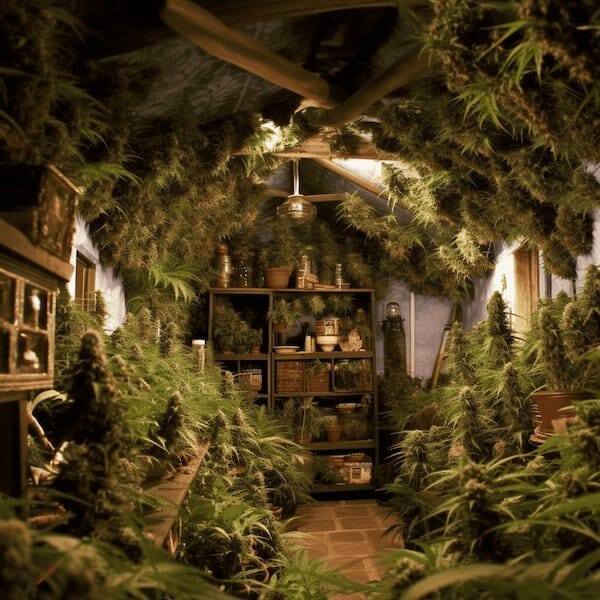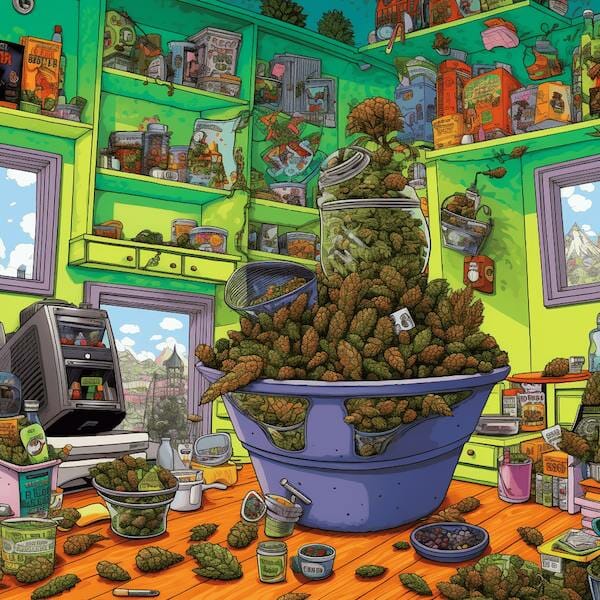Grow Your Own Cannabis at Home: The Benefits and How-To Guide

Grow Your Own Cannabis at Home: The Benefits and How-To Guide
Weed and cannabis may just seem like a way to party and have fun, but did you know growing your own cannabis at home actually has a range of unique benefits? From being more cost-effective and better tasting to providing an unmatched sense of satisfaction in the harvest and quality control, growing your cannabis can be a rewarding experience.
But before you start getting dizzy with dreams of growing your own crop of super-sticky buds, you need to know the nitty-gritty details about the benefits and how-to guide for growing your own cannabis at home.
So settle in, spark a joint, and let’s learn more about the world of growing your own cannabis at home!
Quick Recap of Key Points
Growing cannabis at home allows for more control over the growth process, more accessible access to quality plants, and potential savings on purchase prices. It can also provide an enjoyable hobby for those interested in learning more about the plant.
Economical Benefits
The economic benefits of growing your cannabis at home are significant, and there are several that could potentially benefit growers. For one, many people prefer to purchase their own cannabis directly from a grower rather than from a dispensary or store. This can provide them with fresher plants and reduce the cost of buying cannabis from a third-party seller. It also bypasses laws for taxation on marijuana purchases in some states. Additionally, home-grown cannabis does not require packaging materials and other costs associated with selling and distributing cannabis products.
Another potential financial benefit is that growing your own plants can help you save money on new purchases; instead of buying pre-made cannabis, you can use the same seed stock over and over again. This eliminates any additional expenses associated with purchasing newly developed strains. Furthermore, it allows growers to be more creative by cultivating their unique strains through cross-breeding techniques.
Finally, growing your cannabis can also help an individual save money in the long run. With careful planning and monitoring of ideal conditions, growers may be able to produce consistent quality yields every season without having to worry about purchasing additional equipment or supplies for harvesting each batch.
Overall, both self-taught starters and experienced veterans of home growing can gain significant economic benefits from learning how to cultivate their personal bud harvests. Now that we have discussed what types of advantages there are with the economic aspects of this lifestyle, let’s take a look at how cost-effectiveness plays a role in the home grower’s experience.

Main Takeaways
Growing cannabis at home has several economic benefits, including cheaper prices for fresher plants, savings from not needing to buy new strains, and cost savings in the long run from avoiding the need to buy additional equipment or supplies. Home growers can be self-taught starters or experienced veterans and can save money while having the experience of growing their personal bud harvests.
Cost Effectiveness
As the popularity of growing cannabis at home steadily increases, so does the importance of discussing its cost-effectiveness. On the one hand, there is undoubtedly an initial monetary investment required for the set-up and operation of your cannabis grow room. There are the necessary items such as equipment, seeds, and soil—not to mention any extra electrical costs associated with running lights and fans. Depending on the size and complexity of your project, this could range from several hundred to even a thousand or more dollars.
On the flip side, however, growing weed at home certainly has its economic benefits. For example, purchasing pre-packaged buds can be expensive depending on where you live, especially if you are a frequent consumer. It can quickly become even pricier if you are factoring in dispensary taxes. By contrast, when you cultivate your crop at home, you can save a lot of money on what can add up to an undesirable expense after some time. Furthermore, with proper knowledge and experience, most growers can expect high yields with increased potency levels that felt dispensaries simply cannot compete with.
All in all, then, while it certainly requires an initial financial investment to get started with cannabis cultivation at home, the cost-benefit over time can be great for those who are willing to put in the effort and make sure their project succeeds. With that said, before growing your first crop, it is important to consider other factors, such as safety and legal obligations relating to your area’s regulations.
Safety and Legal Considerations
After considering the cost-effectiveness of home-growing cannabis, it is equally important to consider safety and legal considerations when growing your plants. Safety first: growing cannabis indoors can be complicated and potentially dangerous as it requires electrical wiring for lighting systems, water for irrigation systems, and ventilation for temperature control. Any kind of wiring should be done by a certified professional or with extreme caution if done independently; incorrect wiring increases the risk of fire hazard or electrocution. Additionally, water and home-based pressurized irrigation systems require caution to prevent water damage inside the house or mold growth.
The legal considerations of growing cannabis at home also vary significantly by region. While some states allow up to six plants per person with no penalty associated, other jurisdictions have much higher penalties for those who fail to comply with their laws, including hefty fines and imprisonment. Prospective growers must research the legal requirements in their area before proceeding with cultivating marijuana plants in their homes. According to a Government of Canada report, most provinces only permit individuals over 18 to grow cannabis in private residences as long as they remain within the legal limit of four plants per household.
Safety and legal considerations are essential aspects of planning when considering cannabis cultivation at home. Although risky, taking these elements into account before taking any steps will help ensure that everyone involved enjoys a safe experience. To learn more about how “legal” this activity can be, our next section will review certain jurisdictions where growing cannabis at home is a reality.
- Growing cannabis at home can save an average of 25% or more on cannabis costs each month.
- A study published in 2019 found that growing cannabis plants indoors can provide better control over temperature, lighting, and humidity than outdoor growing conditions.
- According to research published by The National Institutes of Medicine, growing cannabis at home provides better control over the plant’s chemical composition, which improves the quality of the product and may reduce health risks associated with unsafe levels of toxins.

Growing Cannabis in Your Home Is Legal
When growing cannabis in your home, the laws can be complex and vary by location. The legality of cannabis cultivation is an ongoing issue that has sharpened in recent years as more states move to legalize recreational cannabis consumption. With this being said, it would be wise for anyone considering cultivating cannabis at home first to become knowledgeable about their area’s laws.
In many parts of the United States, for example, growing cannabis on a personal or small scale is legal under certain conditions. These conditions often include a set number of mature plants with or without possession limits despite the state’s prohibitions on selling or distributing the drug without a license. In some areas, medical marijuana users are allowed to grow more significant amounts with a doctor’s recommendation but even in those cases, additional restrictions may still apply.
Furthermore, within states where recreational marijuana consumption is legal specific laws governing individual cultivation still apply. This is due to product safety and quality control concerns if people attempt to grow their own instead of purchasing from trusted stores and dispensaries. Such regulations include plant counts, seed purchases only from licensed vendors, and specific distancing requirements between greenhouses and residential homes and buildings.
Overall, despite most regions having made progress towards decriminalizing marijuana use on both medical and recreational fronts, there are still many grey areas regarding individual cultivation that must be addressed before diving into the practice. Although it is seemingly tempting to start your private plantation without any repercussions due to decreasing stigma surrounding marijuana use, taking the time to research local regulations and comprehend possible consequences is truly necessary before beginning the process to avoid potential legal issues down the line.
For experienced cultivators who have made sure they understand all relevant laws though, starting a grow-your-own setup has various benefits that come with it, such as quality control, strain selection control, cost efficiency, and more. To understand why hemp cultivators seek these advantages, let us look into what makes them attractive next.
Experienced Cultivator Advantages
For experienced cultivators, growing cannabis in your home can be an enriching experience. With legal regulations a growing concern among commercial growers, having the ability to experiment and learn without fear of legal repercussions can offer more creative freedom than ever before. Additionally, anyone cultivating marijuana alone can perfect their skills while learning how to manage pests, molds, and nutrient problems far better. Cultivating cannabis at home also means that growers can easily maintain a consistent quality throughout all stages of the cultivation process while gaining the knowledge necessary to increase yields and maximize quality in the future.
At the same time, experienced cultivators need to stay up to date with local regulations and laws, as even though growing cannabis may be legal in some jurisdictions, it does not mean it is regulation-free. Guidelines for home cultivation vary from place to place, and not adhering to them could lead to costly fines or even jail time. Therefore, staying informed about any changes or new laws concerning home cannabis cultivation is essential for experienced cultivators to remain compliant.
Having the ability to cultivate cannabis at home offers numerous advantages for experienced green thumbs. From increased creative freedom to perfecting one’s skills and growing quantities of yields and quality, home cultivation is no longer reserved for either government-run dispensaries or black market dealers as more jurisdictions are legalizing this activity. As always, it is critical to stay knowledgeable about local regulations impacting home cultivation so that everything remains compliant as we look toward the future of this industry. Having said that, now let’s explore what types of yields home cultivation can offer, which is sure to be a topic worthy of discussion!
Quality and Quantity of Yields
Growing your cannabis at home offers a unique opportunity to produce quality, customized yields that suit the needs and tastes of the individual grower. For experienced cultivators, in particular, their technical expertise allows them to precisely adjust nutrition, light, and soil condition variables, resulting in highly concentrated THC levels and abundant yields. On the other hand, non-experts often face challenges in replicating ideal conditions before harvest time, limiting overall productivity and yield quality.
Fortunately, there are many resources available online that provide beginner-friendly tutorials with step-by-step instructions on setting up an optimal environment for successful crop growth. Many of these resources offer pre-programmed automation control systems that allow users to easily regulate the climate with minimal effort and still achieve high yields and efficient harvests. There is also evidence that shows more frequent harvesting cycles than what would normally be recommended by professionals can result in higher yield production over time.
It is also important to note that no two cannabis growing cycles will ever be identical due to a multitude of contributing factors, from genetics and natural environment boundaries to the amount of light exposure, etc. However, when conducted with knowledge and diligence, even novice growers should be rewarded with considerable yields of top-quality cannabis flowers from their backyard gardens.
In conclusion, it cannot be understated how crucial external growing conditions are when attempting to maximize yields for either experienced or novice home cultivators. Therefore it is important for growers of any skill level to explore options for optimizing lighting and soil condition variables carefully before embarking on their next harvesting endeavor.

Lighting and Soil Conditions
As light and soil conditions are essential to plant growth, they are also crucial components when growing cannabis at home. The type and amount of light, combined with the pH balance of the soil, will determine the quality and quantity of your cannabis yields.
Unfortunately, not many cannabis growers can be experts in both horticulture and electricity. Experienced growers suggest that light should come from two sources to ensure abundant growth: sunshine as well as grow light. For safety reasons, natural sunlight is preferable for plants grown outside, while a combination of LED or High-Intensity Discharge (HID) electrical lamps is ideal for plants grown inside. Grow lights should be suspended no farther than 12 inches away from the top of the plants and set on a timer to ensure that each plant receives at least 18 hours of light each day.
When it comes to soil conditions, it’s important to find a pH-balanced soil mix that is somewhere between 6.0 and 7.0 and slightly acidic (1-5 percent organic matter). A good combination for most gardens would contain peat moss, perlite or vermiculite, and either potting soil or compost. It’s best to mix this together before adding any water or fertilizer so you can pick up any chunks or large clumps that may reduce drainage or affect the pH level of the dirt. If you’re concerned about your soil being too alkaline, then you can adjust it with some treated water or lime powder.
The optimal conditions for cannabis growth are often debated, but when carefully managed, one can drastically increase the quality and quantity of their yields by taking control of the lighting and soil conditions. With just some time, research, practice, and dedication, you can perfect these variables within your own grow setup until you begin yielding exactly what you need; whether that be large buds full of resin and terpenes or smaller buds dense with cannabinoid content.
Now transitioning to our next section, let’s discuss how we can protect our plants by providing them with a natural environment free from synthetic chemicals and additives while still making sure they get everything they need to achieve optimal growth.
Natural Environment and Chemicals
Lighting and soil conditions are key components in growing your own cannabis at home. But, another integral factor is understanding the natural environment and controlling the use of chemicals during growth. Growing indoors provides more control over the environment, while outdoor growing may require more understanding of local conditions, pests, and diseases.
When growing outdoors, it is important to be familiar with seasonal changes in temperature, humidity level, and amount of sunlight. Additionally, knowledge of any local pests or diseases that could target cannabis plants is essential for preventing an infestation that could destroy your entire crop. Fortunately, there are some natural techniques for avoiding these problems, such as introducing beneficial insects like ladybugs or maintaining a healthy ecosystem by adding other plants nearby that can attract predators of pests and diseases.
Indoor growers may have fewer environmental concerns, but choosing organic and sustainable methods can help create a healthier growth environment for cannabis plants and improve their overall yield of usable products. Utilizing organic fertilizers with organic ingredients is an important element for achieving this goal. However, indoor growers sometimes face challenges like pest or mildew outbreaks and must resort to chemical treatments such as insecticides or fungicides. The debate remains over whether to go completely organic or to embrace the use of some synthetic chemicals during times of emergency, as they can offer quick relief from problem areas while still being relatively safe to use.
Ultimately, both indoor and outdoor spaces need to be monitored closely and carefully throughout the growth cycle: ensuring balanced levels of humidity and temperature, following proper nutrition schedules with organic fertilizers, carefully assessing conditions if there are signs of infection or pest infestations while using reasonable amounts of organic or synthetic chemicals if needed. With a strict eye on these factors, a grower has a higher chance of successful harvests free from contamination from harmful substances.

Responses to Frequently Asked Questions with Detailed Explanations
What are the costs involved in growing cannabis at home?
The costs involved in growing cannabis at home can vary depending on the method chosen and the size of the grow operation. The initial setup costs for a home grower may include purchasing soil or hydroponic equipment, seeds or clones, and necessary supplies like nutrients, pumps, and lights. Beyond that, there are ongoing costs for electricity, water, fertilizer, and other supplies like insecticides or fungicides. Additionally, home growers need to factor in their own labor costs for tending to the plants. It’s essential to accurately assess these costs before starting a home grow operation so you don’t end up spending more than necessary.
What types of cannabis plants can be grown at home?
Homegrown cannabis plants can be either Sativa, Indica, or a hybrid, depending on the desired effect you want from your end product. Sativa strains are known for their cerebral, energetic high and can be easily grown at home given the right environment and equipment. Indicas, on the other hand, provide a more calming body-centric experience and are typically more tolerant of temperature extremes. Hybrids are crosses between Sativas and Indicas and can produce a wide variety of effects based on their genetic composition.
Home cultivators may opt for auto-flowering varieties, which require shorter flowering times (usually 8-11 weeks) than traditional photoperiodic strains, which depend on a light cycle to switch from the vegetative to flowering state (typically 10-14 weeks). Autoflowering strains have the benefit of producing yields quicker than photoperiodic varieties, making them an attractive choice for home growers.
To successfully grow cannabis at home, it is essential that the environment is regulated correctly with proper temperature ranges, ventilation, and humidity. Additionally, providing adequate lighting and fertilizer as needed is essential for optimal growth. Utilizing hydroponics methods or soil can also result in larger yields while being cost-effective. Overall, hobbyist home cultivation of cannabis provides an individual an opportunity to produce their own personalized strain specifically tailored to their preferred therapeutic effect or recreational enjoyment.
Are there any legal or safety considerations to consider when growing cannabis at home?
Yes, there are legal and safety considerations to consider when growing cannabis at home.
Legally speaking, it is essential to check the laws in your local jurisdiction before attempting to grow cannabis at home. Depending on where you live, it may be illegal or only allowed for medical purposes. Even if your state or country has legalized or decriminalized possession or use of cannabis for adults over 21, it may still be illegal to grow it at home. So make sure you’re familiar with the local laws before you start.
In terms of safety, you’ll want to make sure that any equipment or tools used to cultivate cannabis are sterile, as any contaminants can lead to harmful mold growth. You’ll also need to provide a safe, secure space where the plants can be monitored away from curious children or pets. Additionally, proper ventilation is essential; not only will this keep your growing area well-aerated and sanitary, but it will also help ensure that odors won’t attract unwanted attention. Finally, ensure that any chemicals used in cultivating the plant are disposed of properly so they don’t enter the environment. Otherwise, you risk creating an even bigger problem.
Conclusion
Growing your own cannabis at home presents a plethora of advantages, such as economic benefits, control over quality, and an enriching personal hobby. There’s the joy of witnessing your seeds sprout into thriving plants and the satisfaction of harvesting the fruits of your labor. Home-growing cuts down the cost of purchasing from dispensaries and eliminates additional expenses such as packaging, taxes, and new strain purchases. While it requires an initial investment, the cost-effectiveness can’t be overlooked in the long run. However, before plunging into this venture, it’s crucial to consider safety measures and understand the legalities surrounding cannabis cultivation in your area. To start your home-growing journey, consider sourcing your seeds from a trusted seed bank, like seedsherenow.com, which houses a variety of top-quality cannabis seeds that cater to all types of growers, from novice to expert.
About Seeds Here Now:
Seeds Here Now is the best U.S. marijuana seed bank, of marijuana strains, for high-quality marijuana seeds. If you love growing marijuana, and marijuana strains, from the best marijuana seeds or cannabis seeds, then Seeds Here Now is the best U.S. seed bank to buy marijuana seeds online from. It’s also the best U.S. seed bank to buy cannabis seeds online. They specialize in high-THC cannabis strains and high-CBD marijuana strains. You can buy them in regular cannabis seeds, autoflower cannabis seeds, and feminized cannabis seed categories. No matter what you call them, hemp seeds, cannabis seeds, marijuana seeds, pot seeds, or weed seeds, all seeds can be found at Seedsherenow.com. Complete with a satisfaction guarantee and free seeds with every order, why shop anywhere else?
Suggested Articles
;)
;)
;)




 03 Jul 2025
03 Jul 2025  10 min read
10 min read


 June 11, 2023
June 11, 2023 


RESPONSES (0)
No responses yet. Be the first to respond!